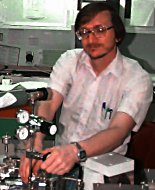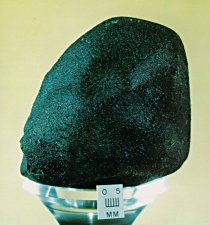Amino acids were discovered in interstellar clouds and meteorites some time ago, but there is one aspect of the chemistry of these life-giving molecules that has remained an enigma – why are some amino acids that we find in living organisms missing from the meteoric menu and, more intriguingly, why do they share a common preference for being left-handed molecules on Earth and in space? Unravelling the answers lies at the very heart of how life on Earth began.
Stephen Macko, Professor of environmental sciences at the University of Virginia in Charlottesville has a terse response to the puzzle – the bottom line is that you have these materials that come from space, he says.

Stephen Macko
More specifically, eight of the amino acids found in carbonaceous chondrites, a type of meteorite, are identical to those used to build proteins by almost every organism on Earth, but why only eight of the 20 earthbound amino acids is unknown. Their presence, Macko explains, points to a cosmic origin for these basic biological building blocks. The early Earth suffered a barrage of meteorite impacts in its youth, the scars of which have long faded but the amino acid legacy remains.
Speaking at a meeting of the Geological Society of America in Seattle in November that celebrated the life and work of the late Glenn Goodfriend, Macko described how the fact that, glycine aside, the amino acids that have been found in meteorites have the same chirality, or handedness, as those in living things, hints at an extraterrestrial origin to the chemical components of life. If we can work out the reason why only left-handed amino acids are found in meteorites and almost every protein, we might find a clearer picture of how life on Earth emerged. Such work might also help in the search for life not of this planet.

Michael Engel
Only in recent years has the idea of amino acids from space affecting the start of life on Earth become a plausible hypothesis, says Macko. Initially, amino acids were thought to have been created in the primordial atmosphere of the early Earth. In a now famous experiment more than a half-century ago, Stanley Miller and Harold Urey at the University of Chicago showed that amino acids were synthesized by simply creating lightning-like electrical discharges through a fog of water, methane and ammonia. This demonstrated that amino acids could be made through non-living processes.

A fragment of the Murchison meteorite, which fell on Australia in 1969 (Credit: NASA)
Perhaps the most famous carbonaceous chondrite was the Murchison meteorite, which fragmented and fell in 1969 in and around the small town of Murchison, Victoria, about 70 miles north of Melbourne, Australia. Amino acids and other organic molecules were found in the Murchison meteorite. Interestingly, the blend of amino acids found in the Murchison meteorite was similar to that measured in Miller-Urey type experiments. The crucial difference was discovered by Michael Engel of the University of Oklahoma who has shown that while Miller-Urey experiments produce both left and right-handed amino acids in equal proportions, the meteorite swung to the left, chemically speaking.
Given the preponderance of impact events during the Earth’s early history and the fact that carbonaceous meteorites contain amino acids, the exogenous delivery of life’s precursors to Earth is a reasonable alternative, he says. Engel adds that assuming that these compounds were life’s precursors, the question is where did the other twelve protein amino acids come from? It is possible that most of these amino acids were also present in carbonaceous meteorites, but diagenetic processes and analytical uncertainties have effectively limited their detection.
Further reading
Stephen Macko
http://atlantic.evsc.virginia.edu/cgi-bin/w3-msql2/personnel/msql2/person.html?QID=smacko
GSA conference 2003
http://gsa.confex.com/gsa/2003AM/finalprogram/index.html
Miller’s experiment
http://www.chem.duke.edu/~jds/cruise_chem/Exobiology/miller.html
Michael Engel
http://geology.ou.edu/people/engel-mh/
Diagenetic processes
http://www.merriam-webster.com/dictionary/diagenetic
Suggested searches
Amino acids
Chirality
Meteorites